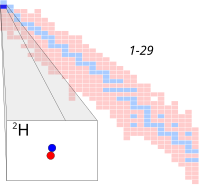
Photo from wikipedia
Free fatty acids involved in many metabolic regulations in human body. In this work, an ultra-fast screening method was developed for the analysis of free fatty acids using trapped ion… Click to show full abstract
Free fatty acids involved in many metabolic regulations in human body. In this work, an ultra-fast screening method was developed for the analysis of free fatty acids using trapped ion mobility spectrometry coupled with mass spectrometry. Thirty-three free fatty acids possessing different unsaturation degrees and different carbon chain lengths were baseline separated and characterized within milliseconds. Saturated, monounsaturated, and polyunsaturated free fatty acids showed different linearities between collision cross section values and m/z. Establishment of correlations between structures and collision cross section values provided additional qualitative information and made it possible to determine free fatty acids which were out of the standards pool but possessed the confirmed linearity. Gas-phase separation made the quantitative analysis reliable and repeatable at a much lower time cost than chromatographic methods. The sensitivity was comparable to and even better than the reported results. The method was validated and applied to profiling free fatty acids in human plasma. Saturated free fatty acids abundance in the fasting state was found to be lower than that in the postprandial state, while unsaturated species abundance was found higher. The method was fast and robust with minimum sample pretreatment, so it was promising in high-throughput screening of free fatty acids. This article is protected by copyright. All rights reserved.
Journal Title: Journal of separation science
Year Published: 2022
Link to full text (if available)
Share on Social Media: Sign Up to like & get
recommendations!